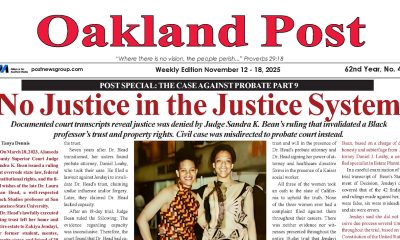National
Sheriff, Lawyer Dispute Whether 73-Year-Old Deputy Qualified

Sheriff Stanley Glanz speaks during a news conference about the reserve deputy Robert Bates’ shooting of Eric Harris on Monday, April 20, 2015. Glanz said he doesn’t believe training records were falsified for a volunteer deputy who said he confused his handgun for his stun gun before fatally shooting Harris this month. (Mike Simons/Tulsa World via AP)
KELLY P. KISSEL, Associated Press
SEAN MURPHY, Associated Press
OKLAHOMA CITY (AP) — The Tulsa County volunteer deputy who shot and killed a suspect after mistaking his handgun for a stun gun was using an unauthorized weapon when he fired the fatal shot, lawyers for the dead man’s family said Monday.
In separate news conferences, the county sheriff and lawyers for the man killed by 73-year-old Robert Bates disagreed on whether the reserve officer should have been on the streets with a badge and a gun.
Sheriff Stanley Glanz said Bates, his longtime insurance agent, had been properly trained and passed annual firearms certifications required by the state.
Dan Smolen, a lawyer for Harris’ family, said the Tulsa County Sheriff’s Office violated a number of its internal policies by letting Bates carry his personal handgun after training at the range on another weapon. Smolen also said the department failed to keep a permanent record of Bates’ training, a violation of local policies.
Records Bates released during the weekend showed that the volunteer officer was trained on a .45, not the weapon used in Harris’ death.
“None of those that are approved by the sheriff’s office own policies include a .357 Smith and Wesson,” Smolen said, while reviewing department records for reporters.
“Firearms training is a critical piece of this story. None of the records produced by the Tulsa County Sheriff’s Office or Mr. Bates’ attorney, whoever produced them, indicate that he was ever certified with a .357 revolver,” Smolen said.
Harris died after running from a sting operation involving illegal gun sales. Bates, who has been charged with second-degree manslaughter, has said that he confused his handgun with his stun gun following a short chase.
The sheriff said it was proper to have Bates on the scene with eight other officers during an investigation into illegal gun sales.
“Mr. Bates has been to the range several times and is qualified, and that is documented,” the sheriff said.
Smolen reviewed documents Bates released showing passing scores at the shooting range, though some efforts were marked below the 72 percent passing grade.
Using a slideshow, he said Tulsa sheriff’s department policies require that guns used on-duty be the same as those used at the range, unless an officer is off-duty before being called to respond.
State law enforcement training standards do not require that the weapons be the same, but do allow counties and local police to set their own guidelines.
Under those same state standards, once people are certified as law officers they remain authorized to work as long as they maintain weapons skills and aren’t de-certified for reasons as varied as being convicted of major crimes or involuntarily committed to a mental health facility.
“Whether they are hired by a particular department or meet that department’s requirements … that is up to the individual department, not CLEET,” said James Wilson, the general counsel for the Council on Law Enforcement Education and Training. “If the Tulsa County Sheriff’s Office wants to commission them, that’s their business, as long as they’re certified.”
Bates, who sold his insurance business for $6 million in 1999, was trained to be a Tulsa Police Department patrolman in 1964 but left in 1965. He was out of law enforcement for 35 years, returning for volunteer work in Florida in 2000-01 — doing ride-alongs — before joining the Tulsa County force in 2008 and making a number of donations to the agency. He also was Glanz’ campaign manager during the 2012 election.
There was no record of why Bates left the Tulsa Police Department. The agency said it destroys old personnel files after five years.
Glanz’ office has said it, too, cannot find all of Bates’ records. Monday, Glanz said some of those records could have been destroyed under a new state law that allows agencies to throw away old records after seven years.
“I don’t doubt for a second that they can’t find these records,” said Sen. Brian Crain, a Republican from Tulsa who sponsored the bill. “It’s a bureaucracy, and with any bureaucracy you’re going to lose track of some records.” He said he couldn’t recall if it was Glanz or the state Sheriffs Association that asked for the bill.
Glanz, the local sheriff since 1989, was on the Commission of Accreditation for Law Enforcement Agencies from 2000 to 2005 and said he believed that age standards may be considered in response to Harris’ death.
“We follow the national standards. I think that we will be reviewing the national standards for our reserves and age may be an element of that,” Glanz said.
But Craig Hartley, CALEA’s executive director, said Monday no one has asked for a review, and any mandatory retirement age might not survive a federal court challenge under equal employment laws.
Glanz also said Monday that action will be taken against two deputies at the scene, including one caught on video cursing at Harris as he lay dying. The sheriff said both have received threats and have been reassigned.
“We will review what those officers did and will take some administrative action,” the sheriff said, but didn’t provide specifics.
The FBI said Monday it had concluded that a civil rights investigation into Harris’ death was not warranted “at this time.”
The Tulsa World newspaper, citing unidentified sources, has reported that some of Bates’ supervisors were told to certify him after he failed to meet some qualifications. Bates released his records Saturday in an effort to refute that claim.
The reporter and editor on the Tulsa World story have resigned “to pursue other opportunities,” the newspaper said on its website. Another reporter also leaving the paper said the departure had been in the works for weeks, even before Bates shot Harris.
“We always intended to give notice this week,” said former World reporter Cary Aspinwall, who is married to an AP reporter. “This all happened before he shot the guy.”
___
Kissel reported from Little Rock, Arkansas. Associated Press writers Justin Juozapavicius in Tulsa and Allen Reed in Little Rock contributed to this report.
Copyright 2015 The Associated Press. All rights reserved. This material may not be published, broadcast, rewritten or redistributed.
Alameda County
Seth Curry Makes Impressive Debut with the Golden State Warriors
Seth looked comfortable in his new uniform, seamlessly fitting into the Warriors’ offensive and defensive system. He finished the night with an impressive 14 points, becoming one of the team’s top scorers for the game. Seth’s points came in a variety of ways – floaters, spot-up three-pointers, mid-range jumpers, and a handful of aggressive drives that kept the Oklahoma City Thunder defense on its heels.

By Y’Anad Burrell
Tuesday night was anything but ordinary for fans in San Francisco as Seth Curry made his highly anticipated debut as a new member of the Golden State Warriors. Seth didn’t disappoint, delivering a performance that not only showcased his scoring ability but also demonstrated his added value to the team.
At 35, the 12-year NBA veteran on Monday signed a contract to play with the Warriors for the rest of the season.
Seth looked comfortable in his new uniform, seamlessly fitting into the Warriors’ offensive and defensive system. He finished the night with an impressive 14 points, becoming one of the team’s top scorers for the game. Seth’s points came in a variety of ways – floaters, spot-up three-pointers, mid-range jumpers, and a handful of aggressive drives that kept the Oklahoma City Thunder defense on its heels.
One of the most memorable moments of the evening came before Seth even scored his first points. As he checked into the game, the Chase Center erupted into applause, with fans rising to their feet to give the newest Warrior a standing ovation.
The crowd’s reaction was a testament not only to Seth’s reputation as a sharpshooter but also to the excitement he brings to the Warriors. It was clear that fans quickly embraced Seth as one of their own, eager to see what he could bring to the team’s championship aspirations.
Warriors’ superstar Steph Curry – Seth’s brother – did not play due to an injury. One could only imagine what it would be like if the Curry brothers were on the court together. Magic in the making.
Seth’s debut proved to be a turning point for the Warriors. Not only did he contribute on the scoreboard, but he also brought a sense of confidence and composure to the floor.
While their loss last night, OKC 124 – GSW 112, Seth’s impact was a game-changer and there’s more yet to come. Beyond statistics, it was clear that Seth’s presence elevated the team’s performance, giving the Warriors a new force as they look to make a deep playoff run.
#NNPA BlackPress
LIHEAP Funds Released After Weeks of Delay as States and the District Rush to Protect Households from the Cold
BLACKPRESSUSA NEWSWIRE — The federal government has released $3.6 billion in home heating assistance after a delay that left states preparing for the start of winter without the program’s annual funding.

By Stacy M. Brown
Black Press USA Senior National Correspondent
The federal government has released $3.6 billion in home heating assistance after a delay that left states preparing for the start of winter without the program’s annual funding. The Low-Income Home Energy Assistance Program, known as LIHEAP, helps eligible households pay heating and cooling bills. The release follows a shutdown that stretched 43 days and pushed agencies across the country to warn families of possible disruptions.
State officials in Minnesota, Kansas, New York, and Pennsylvania had already issued alerts that the delay could slow the processing of applications or force families to wait until December for help. In Pennsylvania, more than 300,000 households depend on the program each year. Minnesota officials noted that older adults, young children, and people with disabilities face the highest risk as temperatures fall.
The delay also raised concerns among advocates who track household debt tied to rising utility costs. National Energy Assistance Directors Association Executive Director Mark Wolfe said the funds were “essential and long overdue” and added that high arrearages and increased energy prices have strained families seeking help.
Some states faced additional pressure when other services were affected by the shutdown. According to data reviewed by national energy advocates, roughly 68 percent of LIHEAP households also receive nutrition assistance, and the freeze in multiple programs increased the financial burden on low-income residents. Wolfe said families were placed in “an even more precarious situation than usual” as the shutdown stretched into November.
In Maryland, lawmakers urged the Trump administration to release funds after the state recorded its first cold-related death of the season. The Maryland Department of Health reported that a man in his 30s was found outdoors in Frederick County when temperatures dropped. Last winter, the state documented 75 cold-related deaths, the highest number in five years. Rep Kweisi Mfume joined more than 100 House members calling for immediate federal action and said LIHEAP “is not a luxury” for the 100,000 Maryland households that rely on it. He added that seniors and veterans would be placed at risk if the program remained stalled.
Maryland Gov. Wes Moore used $10.1 million in state funds to keep benefits moving, but noted that states cannot routinely replace federal dollars. His administration said families that rely on medical equipment requiring electricity are particularly vulnerable.
The District of Columbia has already mapped out its FY26 LIHEAP structure in documents filed with the federal government. The District’s plan shows that heating assistance, cooling assistance, weatherization, and year-round crisis assistance operate from October 1 through September 30. The District allocates 50 percent of its LIHEAP funds to heating assistance, 10 percent to cooling, 13 percent to year-round crisis assistance, 15 percent to weatherization, and 10 percent to administrative costs. Two percent is used for services that help residents reduce energy needs, including education on reading utility bills and identifying energy waste.
The District’s plan lists a minimum LIHEAP benefit of $200 and a maximum of $1,800 for both heating and cooling assistance. Crisis benefits are provided separately and may reach up to $500 when needed to resolve an emergency. The plan states that a household is considered in crisis if it has been disconnected from energy service, if heating oil is at 5 percent or less of capacity, or if the household has at least $200 owed after the regular benefit is applied.
The District’s filing notes that LIHEAP staff conduct outreach through community meetings, senior housing sites, Advisory Neighborhood Commissions, social media, posters, and mass mailings. The plan confirms that LIHEAP applicants can apply in person, by mail, by email, or through a mobile-friendly online application and that physically disabled residents may request in-home visits.
As agencies nationwide begin distributing the newly released funds, states continue working through large volumes of applications. Wolfe said LIHEAP administrators “have been notified that the award letters have gone out and the states can begin to draw down the funds.”
#NNPA BlackPress
Seven Steps to Help Your Child Build Meaningful Connections
BLACKPRESSUSA NEWSWIRE — Swinging side by side with a friend on the playground. Sharing chalk over bright, colorful sidewalk drawings. Hiding behind a tree during a spirited game of hide-and-seek. These simple moments between children may seem small, but they matter more than we think

By Niyoka McCoy, Ed.D., Chief Learning Officer, Stride/K12
Swinging side by side with a friend on the playground. Sharing chalk over bright, colorful sidewalk drawings. Hiding behind a tree during a spirited game of hide-and-seek. These simple moments between children may seem small, but they matter more than we think: They lay the foundation for some of life’s most important skills.
Through everyday play, young children begin learning essential social and emotional skills like sharing, resolving conflicts, showing empathy, and managing their emotions. These social skills help shape emotional growth and set kids up for long-term success. Socialization in early childhood isn’t just a “nice-to-have”—it’s essential for development.
Yet today, many young children who haven’t yet started school aren’t getting enough consistent, meaningful interaction with peers. Research shows that there’s a decline in active free play and peer socialization when compared to previous generations.
There are many reasons for this. Children who are home with a parent during the day may spend most of their time with adults, limiting opportunities for peer play. Those in daycare or preschool may have restricted free play, and large classrooms can reduce supervision and social coaching. Some children live in rural areas, are homebound due to illness, have full schedules, or rely on screens to fill their playtime. And for some families, finding other families with young children to connect with isn’t easy.
While these challenges can feel significant, opportunities for connection still exist in every community. Families can take simple steps to help children build friendships, create a sense of belonging, and strengthen social skills. Here are some ideas to get started:
- Storytime sessions at libraries or local bookstores
- Community offerings such as parent-child workshops, art, music, gymnastics, swimming, or sports programs
- Weekly events at children’s museums, which may include art projects, music workshops, or science experiments
- Outdoor exploration, where kids can play with peers
- Local parenting groups that organize playdates and group activities
- Volunteer opportunities where children can participate, such as pet adoption events or packing meals at a food bank
- Classes for kids at local businesses, including hardware, grocery, or craft stores
Some of these community activities are free or low-cost and give kids the chance to build friendships and practice social skills. Parents can also model positive social behavior by interacting with other parents and encouraging their children to play with their peers.
These may seem like small moments of connection, but they can have a powerful impact. Every time your child shares a toy, plays make-believe with peers, or races a friend down the slide, they’re not just playing—they’re learning the skills that build confidence, empathy, and lasting friendships. And it’s good for you, too. Creating intentional opportunities for play also helps you strengthen your own network of parents who can support one another as your children grow together.
-

 Activism3 weeks ago
Activism3 weeks agoOakland Post: Week of November 12 – 18, 2025
-

 Activism2 weeks ago
Activism2 weeks agoIN MEMORIAM: William ‘Bill’ Patterson, 94
-

 Activism3 weeks ago
Activism3 weeks agoHow Charles R. Drew University Navigated More Than $20 Million in Fed Cuts – Still Prioritizing Students and Community Health
-

 Bay Area3 weeks ago
Bay Area3 weeks agoNo Justice in the Justice System
-

 #NNPA BlackPress3 weeks ago
#NNPA BlackPress3 weeks agoThe Perfumed Hand of Hypocrisy: Trump Hosted Former Terror Suspect While America Condemns a Muslim Mayor
-

 #NNPA BlackPress2 weeks ago
#NNPA BlackPress2 weeks agoTrump’s Death Threat Rhetoric Sends Nation into Crisis
-

 #NNPA BlackPress4 weeks ago
#NNPA BlackPress4 weeks agoProtecting Pedophiles: The GOP’s Warped Crusade Against Its Own Lies
-

 #NNPA BlackPress3 weeks ago
#NNPA BlackPress3 weeks agoIn Major Win for Rep. Al Green, Texas Maps Blocked by Federal Judge





























































